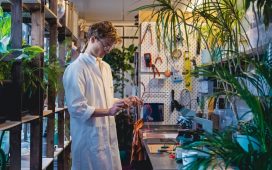Frankly, the process has been going at a snail’s pace.
In 2019 the Australian government began a risk analysis on bringing European molluscs into the country for breeding and, eventually, eating.
Now farmers hope that early next year they will finally learn whether importing live garden snails – Cornu aspersum – will be permitted.
C aspersum is the common garden snail found all over Australia, probably brought here on boats more than a century ago. The farmers want to bring over the bigger European version to start breeding programs here.
They would then provide snail meat (the escargot) and snail eggs (caviar) to restaurants.
C aspersum is a pest, a destroyer of crops, a muncher of gardens.
In its draft plan, the agriculture department says the breed-stock must come from approved snail farms in approved countries and have the relevant government certification. They would be imported into a quarantine facility, then individually examined. The department would demand the “sacrifice” of some via dissection.
They would then be bred for the next generation to ensure they are free of pathogens, after which they would be released to farmers.
Victoria and Nick Howe founded South West Snails in Western Australia during the pandemic. She says they are already breeding bigger local snails to supply restaurants by mating the larger ones of those they pluck from vineyards.
“We don’t have enough to fill demand,” she says.
The snails are put on breeding tables with soil, where they lay their eggs. Howe says once they know which snails they are selling, they “purge” them.
That can mean feeding the gastropods herbs such as dill or thyme, greens, cornmeal or oatmeal. The chef Gordon Ramsay recommends carrots.
“I’ve created my own snail mix using local WA grains,” Howe says. “They have that for a couple of days, then just water for a couple of days, then they go into refrigeration which puts them into hibernation. We ship them live.”
Then, in restaurant kitchens, the snails are cooked in boiling water, trussed up and served.
Both sexes at once
Breeding snails is not always as easy as that sounds.
They are hermaphrodites and in some cases can fertilise themselves, but generally prefer a partner.
In 2016 University of the Sunshine Coast researchers uncovered more details of the molluscs’ sex lives.
after newsletter promotion
Their use of “love darts” or “Cupid’s arrows” had been known for some time – the snails stab each other as they mate. The research found that dart injects a pheromone into the other snail, increasing its ability to reproduce.
The genital orifice – containing both the male and female genitals – is behind the head on the right hand side. They act as both sexes at once when they mate.
Tarryn Williams Clow is a senior zookeeper and leads Taronga Zoo’s Norfolk Island land snail conservation program. Her team has successfully revived the population of Advena campbellii, Campbell’s keeled glass snail, which was thought to be extinct until its rediscovery in 2020.
Unlike C aspersum, the Norfolk Island snails do not lay eggs.
“Ours actually give birth,” Clow says. “A whole entire baby snail comes out of their neck. It’s pretty wild to see.”
She says their birth tract looks a bit like a conveyor belt. “There’d be a fully formed snail. Behind that a less developed one, and behind that an even less developed one.”
The team needed to figure out how the molluscs reproduced, so they studied other snails. Although she says they are all “very, very different”, there are some similarities.
“They are hermaphrodites, so they have both male and female genitalia – some species can self fertilise,” she says.
“We don’t know if ours [can], and we haven’t actually observed them mate because they’re nocturnal.
“They both have a penis that comes out of their genital pore on their neck.”
One result of the way snails mate is that rare goofyfooters, whose shells coil to the the left instead of the right, have trouble finding partners.
Their genitals are on the opposite side to normal. One researcher made global news searching for a mate for Jeremy, a snail whose shell coiled to the left. He found a similar left-coiled snail, and found that two lefties can make a right.
Once the government releases the final report, it will develop guidelines for importation, clearing the way for the European escargot to grace Australian tables.










